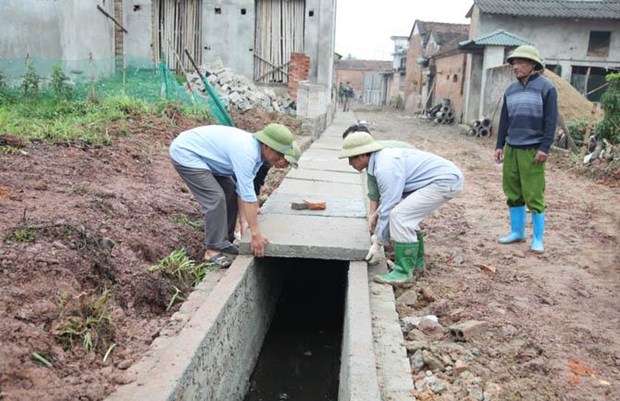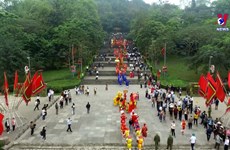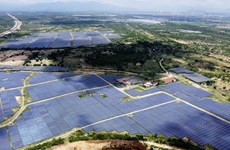Vinh Phuc mobilises nearly 13 trillion VND for rural development
The northern province of Vinh Phuc has successfully mobilises nearly 12.9 trillion VND (555 million USD at current exchange rate) over the past decade for the building of new-style rural areas.
 Residents in Dong Ich commune in Lap Thach district work to upgrade local sewage system (Photo: ntmoi.vinhphuc.gov.vn)
Residents in Dong Ich commune in Lap Thach district work to upgrade local sewage system (Photo: ntmoi.vinhphuc.gov.vn)Vinh Phuc (VNA) – The northern province of Vinh Phuc has successfully mobilises nearly 12.9 trillion VND (555 million USD at current exchange rate) over the past decade for the building of new-style rural areas.
The figure was reported at a recent conference to review Vinh Phuc’s 10-year implementation of the national target programme on new-style rural building for 2010-2020, which was held by the provincial People’s Committee.
Of the amount of money, over 7.8 trillion VND (almost 61 percent) was sourced from the provincial budget, 25.5 percent from credit sources, 0.78 percent from the State budget, and the remainder came from contributions of local communities and other sources. Local residents have to date donated thousands of working days to building rural roads and public buildings.
As a result, as of September this year, Vinh Phuc had 109 out of its total 112 communes meeting all criteria for new-style rural areas. It is striving to have 100 percent of its commune fulfill the standards by the end of this year.
As results of the 10-year implementation of the programme, 1,968 km of rural roads in Vinh Phuc have been cemented, all canals and ditches repaired, and more than 300 irrigation facilities such as pumping stations, reservoirs and dams upgraded. Vinh Phuc has also built 2,035 new classrooms for students and put into operation 65 out of its 66 planned markets.
Improved rural infrastructure has facilitated the mechanization of agricultural production, thereby boosting productivity, promoting the formation of concentrated production areas, and stimulating the production of safe and quality products meeting higher demand from consumers.
However, Trinh Thi Binh, head of the Agriculture and Rural Development Office in Song Lo district, highlighted difficulties facing the province’s production development and agricultural restructuring, which are two important criteria in the new-style rural area building programme.
According to her, in many localities, farmers have abandoned their rice fields for seasonal jobs that offer higher incomes. However, they still keep their fields rather than leasing them out, just in case outside jobs become less stable.
As such, land leasing or accumulation to form concentrated production areas is not an easy task, she noted, adding that the work requires the participation of scientists and experts in the field.
Speaking at the conference, Chairman of the provincial People’s Committee Nguyen Van Tri stated in the coming time Vinh Phuc will continue focusing on encouraging the application of technologies in agriculture; effectively mobilizing resources for new-style rural building; and stepping up agricultural restructuring.
In the 2010 – 2020 period, the local authorities have directed relevant agencies and localities to increase communication campaigns via diverse activities to boost engagement from residents.
Vinh Phuc plans to set aside some 7 trillion VND (301.3 million USD) to carry out the national target programme on building new style rural area from now to 2025.
The money will be used to construct infrastructure like roads, power transmission grids, clean water supply systems, schools and medical stations. Concerted efforts will be made to improve the living quality of rural residents with poverty rate to be kept under 1 percent and healthcare insurance coverage rate to be raised to 95 percent.
The National Target Programme on New-style Rural Area Building, initiated by the Government in 2010, sets 19 criteria on socio-economic development, politics, and defence, aiming to boost rural regions of Vietnam.
The list of criteria includes the development of infrastructure, the improvement of production capacity, environmental protection, and the promotion of cultural values.
Last year, the Prime Minister issued criteria for model new-style rural commune in 2018 - 2020. There are four groups of criteria that a rural commune should meet in order to earn the title. They include criteria on production, income and household poverty rate, education, health care and culture, environmental protection, and security-order and public administrative service./.













